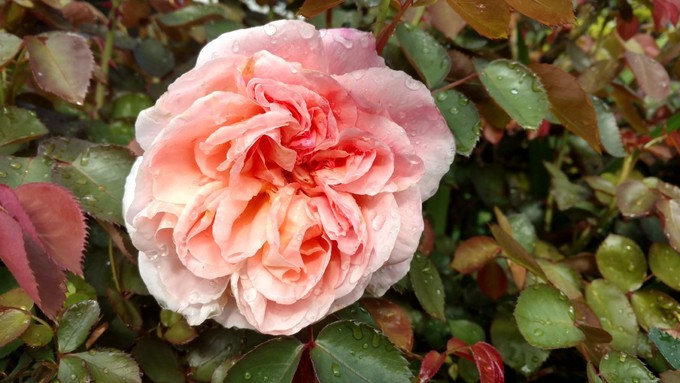
American Rose Society offers free webinar on flower photography

This Tamora rose in the rain was photographed by Debbie Arrington, who has taken Jacqui Nye's class. Debbie Arrington
Rose photographer and exhibitor Jacqui Nye grows lots of other flowers in her Rhode Island garden, too, but roses are her favorite to shoot and share.
She’s not alone; roses are the No. 1 flower on Instagram. By a recent count, more than 80 million Instagram posts feature rose photos, along with the hashtag #rose or #roses. (A distant second are sunflowers at 15.5 million.)
Smartphone and iphones make capturing roses anytime, anywhere a snap. But some simple rules of composition can make a huge difference in results. As Nye says, “you can turn a snapshot into a wow shot.”
Nye recently gave this photo presentation in Sacramento during the American Rose Society’s district conference. Her talk was filled with easy tips for even beginning photographers.
At 11 a.m. Saturday, March 9, Nye will expand on that workshop for an online audience. Part of a series of ARS webinars, this presentation will be two hours, twice as long as her Sacramento talk.
Registration is free and open to anyone, not just ARS members. And Nye’s advice applies to all flowers, not just roses.
Advance registration is required. Sign up here: https://register.gotowebinar.com/register/174998707400148828
Comments
0 comments have been posted.Sacramento Digs Gardening to your inbox.
Sites We Like
Garden Checklist for week of April 21
This week there’s plenty to keep gardeners busy. With no rain in the immediate forecast, remember to irrigate any new transplants.
* Weed, weed, weed! Get them before they flower and go to seed.
* April is the last chance to plant citrus trees such as dwarf orange, lemon and kumquat. These trees also look good in landscaping and provide fresh fruit in winter.
* Smell orange blossoms? Feed citrus trees with a low dose of balanced fertilizer (such as 10-10-10) during bloom to help set fruit. Keep an eye out for ants.
* Apply slow-release fertilizer to the lawn.
* Thoroughly clean debris from the bottom of outdoor ponds or fountains.
* Spring brings a flush of rapid growth, and that means your garden is really hungry. Feed shrubs and trees with a slow-release fertilizer. Or mulch with a 1-inch layer of compost.
* Azaleas and camellias looking a little yellow? If leaves are turning yellow between the veins, give them a boost with chelated iron.
* Trim dead flowers but not leaves from spring-flowering bulbs such as daffodils and tulips. Those leaves gather energy to create next year's flowers. Also, give the bulbs a fertilizer boost after bloom.
* Pinch chrysanthemums back to 12 inches for fall flowers. Cut old stems to the ground.
* Mulch around plants to conserve moisture and control weeds.
* From seed, plant beans, beets, cantaloupes, carrots, corn, cucumbers, melons, radishes and squash.
* Plant onion sets.
* In the flower garden, plant seeds for asters, cosmos, celosia, marigolds, salvia, sunflowers and zinnias.
* Transplant petunias, zinnias, geraniums and other summer bloomers.
* Plant perennials and dahlia tubers for summer bloom.
* Mid to late April is about the last chance to plant summer bulbs, such as gladiolus and tuberous begonias.
* Transplant lettuce seedlings. Choose varieties that mature quickly such as loose leaf.